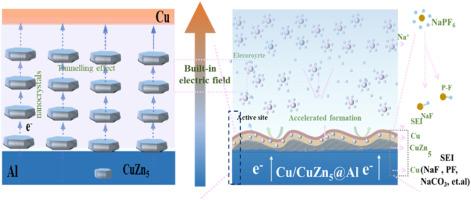Layer-by-layer stacked nano-CuZn5 for conductivity multi-enhancement and surface engineering of anode current collector in dendrite-free sodium metal batteries
IF 9.4
1区 工程技术
Q1 ENERGY & FUELS
引用次数: 0
Abstract
Interfacial instability caused by Na dendrite growth on the anode hinders the further development of sodium metal batteries. To prohibit dendrite growth, constructing anode current collectors with excellent conductivity and surface-regularizing capability is an effective strategy. Here, we report a layer-by-layer stacking design of CuZn5 layer on an Al-based anode current collector. The densely stacked CuZn5 hexagonal nanosheets, working in synergy with the Al substrate and Cu surface layer, significantly enhance the conductivity (50.63 × 106 S m−1) through size-confinement, tunnelling effect, ordered nanostructure, built-in electric field, and surface engineering. This enables fast electron supply/collection for uniform Na plating. Moreover, the layer-by-layer stacked CuZn5 nanosheets induce Cu plating into a rough mountain-like structure with amounts of surface defects, providing abundant active sites for rapid formation of NaF-rich solid electrolyte interphase, which also helps uniform Na plating. The assembled symmetric cell of Na@Cu/CuZn5@Al exhibits low polarization from 0.5 to 5 mA cm−2, and cycles for over 2000 h. The half cell maintains 98 % CE after 500 cycles, whereas cells using Na‖Al and Na‖Cu all show pronounced CE decay within 110 cycles at 1 mA cm−2, 1 mAh cm−2. This work introduces a strategy for fabricating a high-performance, lightweight anode current collector for dendrite-free sodium metal batteries.

层叠纳米cuzn5在无枝晶钠金属电池中电导率多层增强及阳极集流器表面工程研究
阳极上Na枝晶生长引起的界面不稳定性阻碍了钠金属电池的进一步发展。为了防止枝晶生长,构建具有优异导电性和表面规整能力的阳极集流器是一种有效的策略。本文报道了一种在铝基阳极集流器上逐层叠加CuZn5层的设计。通过尺寸限制、隧道效应、有序纳米结构、内置电场和表面工程等因素,通过与Al衬底和Cu表面层协同作用,使CuZn5六方纳米片的电导率显著提高(50.63 × 106 S m−1)。这使得快速电子供应/收集均匀的镀钠。此外,层层堆叠的CuZn5纳米片诱导镀Cu形成粗糙的山状结构,表面存在大量缺陷,为富naf固体电解质界面的快速形成提供了丰富的活性位点,也有助于均匀镀Na。组装的Na@Cu/CuZn5@Al对称电池在0.5至5 mA cm - 2范围内表现出低极化,循环超过2000小时。半电池在500次循环后保持98%的CE,而使用Na‖Al和Na‖Cu的电池在1ma cm - 2和1mah cm - 2下的110次循环内都显示出明显的CE衰减。本工作介绍了一种用于无枝晶钠金属电池的高性能、轻质阳极集流器的制造策略。
本文章由计算机程序翻译,如有差异,请以英文原文为准。
求助全文
约1分钟内获得全文
求助全文
来源期刊

Energy
工程技术-能源与燃料
CiteScore
15.30
自引率
14.40%
发文量
0
审稿时长
14.2 weeks
期刊介绍:
Energy is a multidisciplinary, international journal that publishes research and analysis in the field of energy engineering. Our aim is to become a leading peer-reviewed platform and a trusted source of information for energy-related topics.
The journal covers a range of areas including mechanical engineering, thermal sciences, and energy analysis. We are particularly interested in research on energy modelling, prediction, integrated energy systems, planning, and management.
Additionally, we welcome papers on energy conservation, efficiency, biomass and bioenergy, renewable energy, electricity supply and demand, energy storage, buildings, and economic and policy issues. These topics should align with our broader multidisciplinary focus.
 求助内容:
求助内容: 应助结果提醒方式:
应助结果提醒方式:


